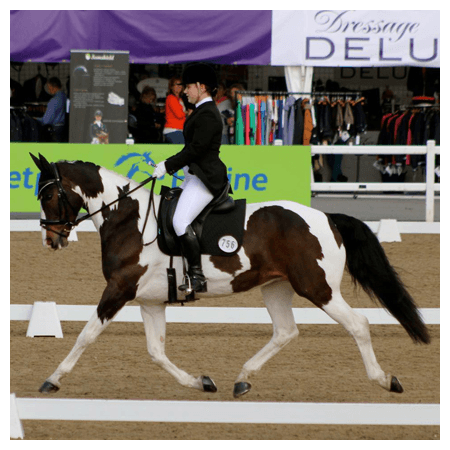Correct Balance
The Importance of Correct Balance
Joanne Hannah & Parnie September 2015
The Importance of Correct Balance

After seeking advice from a vet and our physio re our horses feet, I was given the details of Clive - where I took my horse for a consultation - we found she had been shod all wrong and her shoes far too small. Clive thankfully took us on as a client and WOW what a difference this has made.
My daughter competes in dressage and is also on the British Dressage team for the under 25's Southern. Our horse has always had a nice movement and has done very well - but since the change of farrier is going from strength to strength - recently winning Elementary open Petplan and Medium restricted Qualifiers.
And last week were was at Sheepgate, Boston, Lincs for the National Under 25's Championships - where my daughter competed in 10 tests over the course of a week, being placed in all and winning six of them, on top of that they were 1st in the Elementary Individual Championship and also was on the winning team for BD in the Elementary section.
I would like to say a big thank you to Clive for all his help as we feel his work has been a huge part of the way our horse is going and for that we are truly grateful. Our horses feet are changing for the better and she is a much happier horse now.
Thanks once again Joanne Hannah & Parnie
September 2015
A word from Clive on The Importance of Correct Balance
Farriery is not about nailing metal to horses' feet; it is about removing excess growth and distorting horn to restore function within the individual horse's confirmation.
It is always a privilege to be part of an equine team and it's like Formula One. The rider has to have the skill and knowledge to ask the horse to perform the task in hand; the farrier, body-workers, equine dentists & vets to the team in the pits, all trying to get the horse into a position which will enable it to perform at the best of its ability without stressing or straining its body.
In farriery the trim establishes soundness and the shoe enhances performance. With the trim, the farrier is trying to get the horse's weight to descend through the centre of each joint allowing connective tissue to perform at optimum efficiency.
The shoe should reflect the activity the horse is carrying out and this could best be demonstrated by ourselves. If we play tennis we wear tennis shoes, for football we wear football boots etc. We need to recognise, therefore, that just as with ourselves, the appropriate footwear is essential to support whatever task the horse is being asked to perform and we must change our thinking that if a horse is not shod hunter-style there must be something wrong with the it.
Very few horses hunt today, with most being worked on a variety of surfaces and should, therefore, be shod with shoes appropriate for the activity they are doing and the surface on which they are working.
With the rider's understanding and feedback given to the farrier, fine tuning may occur and it is really satisfying when the small changes made have a big impact on the horse's performance.

“ I have no doubt that it is wholly though Clive’s skill and patience that Fig is still with us today and is comfortably enjoying his happy retirement… Thank you.”
Julia

“Just a word of thanks, to you Clive, for your consistently outstanding care for the horses.”
Mark
Get in touch with Clive
If you would like to know more about Equine Foot Protection or you have specific question about Natural Balance Farriery or to discuss your particular Farriery needs or just to book an appointment please fill out the for below and we will get back to you
Thank you for contacting us.
We will get back to you as soon as possible
We will get back to you as soon as possible
Oops, there was an error sending your message.
Please try again later
Please try again later
About EFP
With over 45 years of experience Clive has dedicated his career to Farriery and the care of Equine Athletes and Friends alike
Contact info
The Forge, Gabriels Farm, Marsh Green Road, Nr Edenbridge, Kent, TN8 5PP
+44 7884 236892
equinefootprotection@gmail.com

